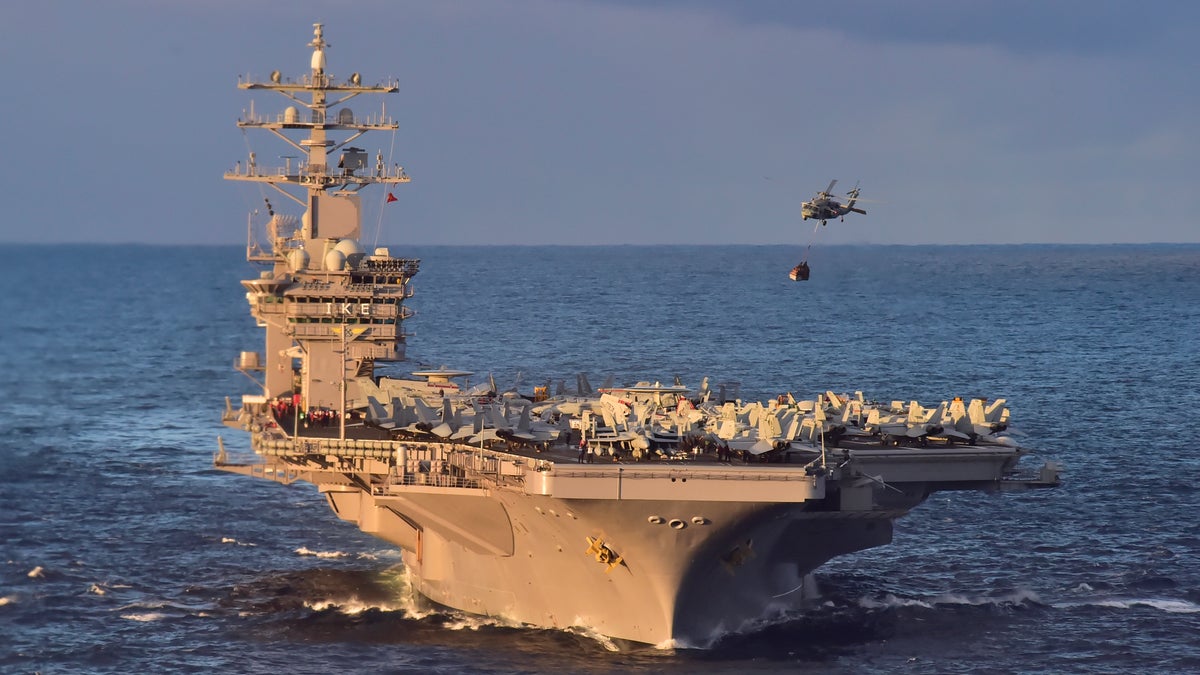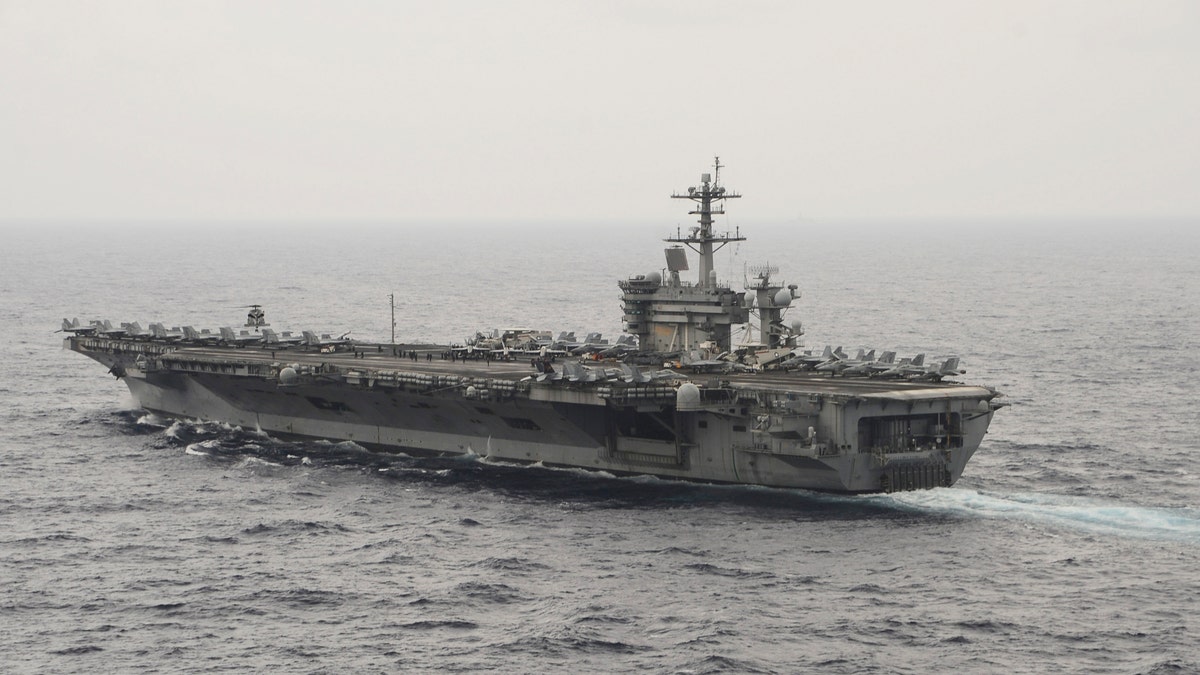
File photo - An MH-60S Sea Hawk helicopter delivers cargo to the aircraft carrier USS Dwight D. Eisenhower (CVN 69) (U.S. Navy photo by Mass Communication Specialist 3rd Class Jameson E. Lynch/Released) (Public Domain)
Sophisticated anti-ship weapons and concerns about the U.S. Navy’s global ‘reach’ highlight the importance of America’s new state-of-the-art aircraft carriers, according to naval experts.
A recent report by Jerry Hendrix of the Center for a New American Security suggested that the aircraft carrier, the backbone of the U.S. Navy since World War II, might soon be threatened by a number of weapons including shore-based anti-ship systems. This report came out as the U.S. Navy revealed that it lacks the capability to provide a continuous aircraft carrier presence in both the Middle East and the Asia-Pacific until at least 2021.
In response to those revelations about carrier capabilities, which were made during a House Armed Services Committee hearing, Rep. Mike Conaway (R-TX) introduced legislation that would increase the number of operational carriers in the U.S. fleet mandated by law from 11 to 12. The Navy has two ships already in its pipeline for deployment.
Back in January 2007 it was decided that this new class would be named the Gerald R. Ford Class, and the first of these, the USS Gerald R. Ford (CVN-78) is currently scheduled to join the Navy's fleet next March. It will make its first deployment in 2019 and is meant to replace the USS Enterprise (CVN-65), which was taken out of active service in December 2012.
Related: 11 stunning F-22 fighter jet images
Features of the Gerald R. Ford class vessels include an updated missile system, a new nuclear reactor design, an Electromagnetic Aircraft Launch System (EALS) and advanced arresting gear.
CVN-78 will be joined by the USS John F. Kennedy (CVN-79) in 2020 and at present the plans are for new ships in this class to enter service in five year intervals until there are a total of 10 Ford-class carriers through 2058. The Ford Class of carriers will have roughly the same displacement as its predecessors in the Nimitz class including the USS George H W Bush (CVN-77). The new class will have between 500 and 900 fewer crew members.
Still a Symbol of Power
At present the United States' 10 carriers – until the Ford comes online – is equal to all the other nations in the world combined. However, the United States is far from the only nation currently building carriers, with a number of nations including the Chinese, British and even Indians now developing aircraft carriers.
"We currently have 10, but other nations are now building carriers," Brad Curran, aerospace and defense industry principal analyst at Frost & Sullivan, told FoxNews.com.

The aircraft carrier USS Theodore Roosevelt (CVN 71) transits the South China Sea in this U.S. Navy picture taken Oct. 29, 2015. (REUTERS/U.S. Navy/Mass Communications Specialist 3rd Class Anthony N. Hilkowski/Handout via Reuters)
Earlier this year it was reported that the Russian navy has begun to develop a new carrier to replace its aging and relatively small Admiral Kuznetsov. Launched in 1985 as part of the Soviet Navy, the ship is showing its age, which could be why the Chinese may have begun to build its first domestic carrier.
Related: 11 amazing A-10 Warthog images
The People's Liberation Army Navy's current carrier, the Liaoning (16) was commissioned in 2012 and became China's first carrier – but it was actually laid down as the Soviet ship Varyag in 1985 but construction ceased in 1992. With the breakup of the Soviet Union ownership of the structurally complete hull was transferred to the Ukraine and it was sold to the Chinese in 1998 and finally commissioned in 2012.
While the Chinese may have developed a "carrier killer" missile there may still be a reason for desiring a carrier – and it isn't for its humanitarian role.
"There is a political angle in that these are a symbol of national power," Lee Willet, head of the naval desk at IHS Jane's told FoxNews.com. "For the Russian Navy it is the center of restoring past glory. Being able to sail past the UK with a carrier was a good expression of power and one the UK took very seriously."
That is why the British are now following America's lead and are building not one but two carriers: the HMS Queen Elizabeth, which is expected to be commissioned next year; and the HMS Prince of Wales, which is expected to follow two years after that.
"Carriers aren't going away," said Curran. "That is why everyone wants one."
Related: Cold War-era weaponry in pictures
"The carrier hasn't sailed into the sunset," he added. "There is nothing that can compare to the flexibility and offer the capabilities of a carrier. It is not just for launching strike aircraft, there are all those other things it can do, ranging from humanitarian to disaster relief."
Curran agreed that the carrier is more vulnerable than ships were 10 or 20 years ago because of a leap forward in shore-to-ship missiles such as the Chinese DF-21D, which has been dubbed by some as a "carrier killer." With a range of 900 miles it could present a serious problem to a carrier, but throughout its history the carrier's defense has always been the aircraft and ships that sail with her. Carriers do not sail out into harm's way alone!”
'Flat Top’ Beginnings
The history of the aircraft carrier actually goes back more than 100 years ago to November 1910 when intrepid aviator Eugene "George" Ely successfully flew off the deck of the cruiser USS Birmingham. Just two months later he landed on the converted cruiser USS Pennsylvania, which had its fantail partly covered by a temporary deck with primitive arresting ropes. After making a successful landing Ely was able to fly off of the same deck and naval aviation was born.
The British Royal Navy was the first to build an actual "aircraft carrier" by opting to complete the battleship HMS Eagle with a flight deck. However, while construction began on the Eagle prior to World War I – and was actually ordered by the Chilean Navy – its construction wasn't completed until after the war. Aircraft played only a minor role in naval aviation during the First World War, but their potential was already being seen.
"There were planes but the use was more for observation than combat," Mark Evans, historian at the Naval History & Heritage Command at the Washington Navy Yard, told FoxNews.com. "The planes of the era lacked the range but also the armament to be effective against warships."
Related: Historic tanks in pictures
Following the First World War the U.S. Navy converted the large collier ship Jupiter into an experimental carrier and she was commissioned as USS Langley in 1922. The Langley was in many ways just the beginning because the U.S. government saw a new and growing threat across the Pacific as the Empire of Japan began building battleships.
The pre-World War I naval rivalry between Great Britain and Germany had helped drive the nations apart and towards war, and the United States hoped to avoid the same course of action. In November 1921 the United States and Japan, along with the British to a lesser extent, agreed to a naval disarmament conference. The result was The Washington Treaty, which sought to limit the number of battleships and battle cruisers that the nations could build.
However, the treaty did allow each signatory to convert two of the battleships under construction into carriers. As a result the USS Lexington and USS Saratoga were far larger than any carriers that were otherwise being considered. This proved to be a significant game changer for naval warfare.
"While a battleship could lob a 2,000-pound projectile 20 miles, carrier-borne aircraft could deposit 2,000 pounds of bombs hundreds of miles away – effectively increasing the range of the fleet's main armament many-fold," David Doyle, author of numerous books on warships, including “USS Lexington CV-2 Squadron At Sea,” told FoxNews.com. "Of course, counter to that is the threat of aerial attack on the fleet. Fighter aircraft effectively lifted the fleet's anti-aircraft defenses from the decks of the ships into the clouds, and increased the range of this anti-aircraft fire from thousands of yards to miles."
Carriers in World War II
It wasn't until the Second World War that this was fully tested, although visionaries such as General William "Billy" Mitchell predicted that air power would be the major threat to battleships and other surface vessels.
Related: History of camouflage in pictures
"It was really the development of the torpedoes that changed the capabilities of airpower," added Evans. "In World War II the Germans and Italians bombed ships but the torpedoes’ ability to strike below the waterline was far more effective."
The ability of carrier-launched aircraft was first demonstrated in November 1940 when the Royal Navy's HMS Illustrious launched a long-range attack on the Italian fleet at its base in Taranto – an action that was carefully studied by the Japanese in preparing for their own attack on Pearl Harbor.
While that attack in December 1941 caught the American fleet by surprise, it was an action six months later that truly demonstrated that the era of the carrier arrived. In May 1942 the Battle of Coral Sea became the first action in which carriers engaged each other and in which neither side's ships sighted or fired directly upon each other.
Carriers in the Cold War
Throughout the Cold War and into the jet age the carrier continued to evolve and these massive vessels proved they could do much more than launch planes. Evans points to the Suez Crisis in 1956 when the British utilized carriers for the transport and deployment of land forces via helicopters.
Related: 10 historic combat helmets
During the Vietnam War, the Gulf War, Operation Enduring Freedom and countless other engagements it has been the carrier that has moved men and material around the world. As a result it might be safe to say that the rumors of the carrier’s demise are truly exaggerated.
"What makes the aircraft carrier effective in what it delivers is not just the ship itself, but the technology that flies off of it, and what else it can put in the air or ashore," Willet told FoxNews.com. "It can launch strike aircraft for combat operations at one end of the scale, down to helicopters carrying emergency supplies to assist in disaster relief operations at the other."
The ocean, Willet, noted is a big place and carriers are continually moving, so first an adversary would need to find the ship. There there is the ring of protection that supports the carrier.
“A carrier battlegroup has an outer ring that consists of early warning, surveillance, and strike aircraft; these aircraft can be deployed in numbers and mixes depending on what the risk to the carrier it," Willet added. "Below the surface there may be a submarine that is forward deployed hundreds of miles ahead.”
“The next layers are the surface ships that include frigates, cruisers and then really close in are destroyers, and again under the surface could be another submarine, there to protect the carrier at close quarters," he explained. "All the time that an adversary may be trying to threaten the carrier, the battlegroup is there trying to stop it. The battlegroup is like the layers of an onion. If an adversary ever managed to peel back the layers and get near the carrier at the core, the battlegroup would have done more than just make the adversary’s eyes water!”




















